This article's main topic of discussion is how custom large language models are revolutionizing industries. Plus, we will also cover LLM use cases.
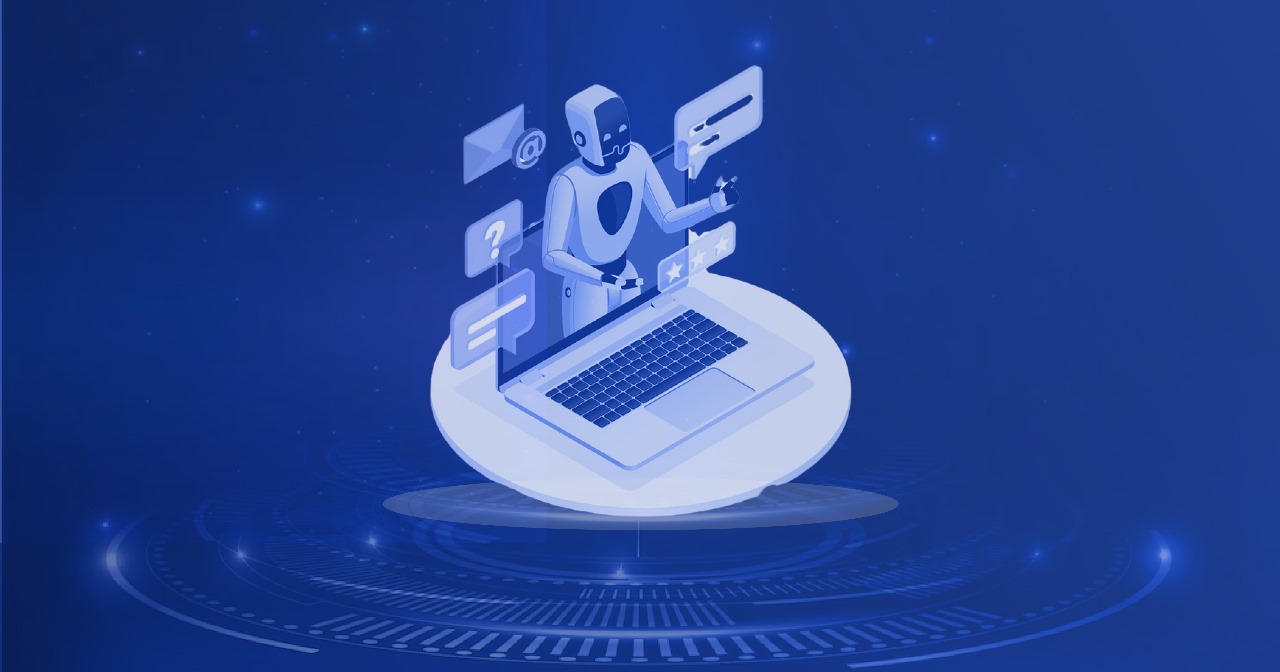
“The ultimate search engine would understand everything in the world. It would understand everything you asked and give you back the exact right thing instantly.”
Larry Page
Just what is that one thing about a large language model that is so fascinating? Large language models have taken the world by storm. Companies are interested in experimenting with LLMs to improve their workflow.
How are industries leveraging the power of LLMs and AI to their advantage? What about LLM use cases? Which are the most popular LLMs? We will discuss each detail.
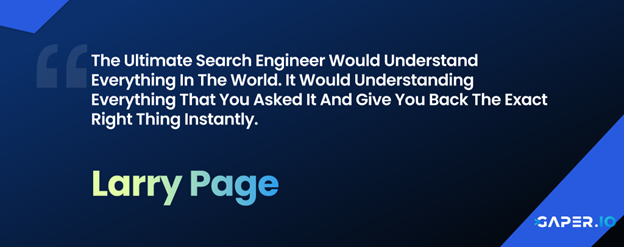
“Under the hood, LLMs use deep learning techniques to build a complex statistical model.”
“They analyze relationships between words in the training data to learn the patterns of human language.”
The LLM Revolution: How AI-Language Models Are Transforming Lives
Before we get into the nitty gritty, it is essential to understand the meaning of large language models. How do LLMs work? Let us find out!!
Who wouldn’t want human-like problem-solving abilities from a machine? Custom LLMs receive industry-specific training according to instructions, text, or code. Therefore, a custom LLM converts the abilities of an LLM and tailors it to a specific task.
As a result, these large language models become more accurate.
According to data from Johnsnowlabs, “Technical leaders value state-of-the-art accuracy (48%), no data sharing with software vendors (44%), and the ability to train their own models (42%) when evaluating machine learning, NLP, or computer vision solutions.”
Accuracy is one of the most prominent qualities of deploying custom large language models. Custom LLMs are the product of fine-tuning large language models.
What would be the reason behind this? Organizations aim to provide a better experience for their customers. Therefore, custom large language models can fill the gap.
Once you teach your LLM the basics, the next step is to fine-tune it. The pretraining process involves large amounts of data. Finetuning LLMs is all about optimizing the model according to your needs.
“Despite the impressive ability of LLMs to generate text in various contexts, they require fine-tuning to perform specific tasks or understand particular domains more accurately.”
“Fine-tuning trains the LLM on task-specific or domain-specific data, thereby enhancing its performance in those areas.”
Archana Vaidheeswaran, data product manager, A Beginner’s Guide to Fine-Tuning Large Language Models
Below are some steps that come under the process of finetuning large language models.
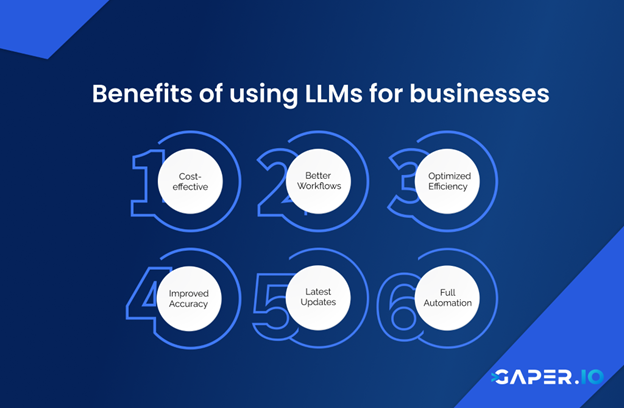
“In the corporate sector, LLMs have changed the rules.”
“Businesses can process and analyze enormous amounts of textual data thanks to their advanced algorithms, completely changing how companies run.”
Now, let’s get to the juicy part! How are custom LLMs helping businesses? Moreover, what are LLM use cases? We shall learn about the effect of LLMs on the workflows of different industries!
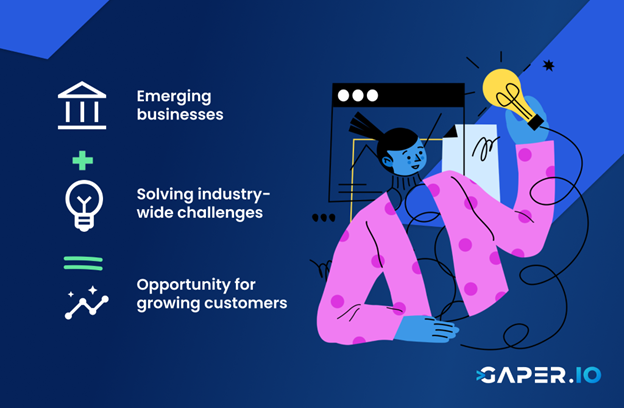
In this fast-paced world, companies do what they can to market their product to the maximum. From figuring out budgets to laying out plans, marketing is no joke.
Custom large language models are an advantageous source of assistance for marketers to organize their work.
“In this rapidly evolving landscape, leveraging the capabilities of LLMs can significantly expand marketing strategies and deliver unprecedented results.”
Anton Vasilescu, a data scientist on LinkedIn
A strong concept is the backbone of a marketing strategy. LLMs can generate multiple ideas and thus amplify the phase of creative concept development.
Custom LLMs can improve email marketing campaigns and social media management. How? They can draft personalized responses, schedule posts across different platforms, and identify SEO gaps.
Managing content can be tricky! Companies struggle with monitoring customer interactions, feedback, and website management. Custom LLMs are a hub of the latest information and trends.
Moreover, these large language models monitor customer data, sentiment analysis, engagement patterns, successful elements, etc.
Have you heard of MedPalm? Perhaps, Glass AI? You can classify these as advanced large language models that guide healthcare organizations, medical professionals, and patients.
Now, it’s time to delve into the details!
The global AI in the healthcare market size will grow from just under $5 billion in 2020 to $45.2 billion by 2026. (Marketsandmarkets.com)
Healthcare is one of the most prominent custom LLM use cases.
Arranging reports and patient documentation is a big hassle. This is where custom large language models can save the day! Through natural language processing, healthcare LLMs can extract insight from clinical text, medical records, and notes.
As a result, the risk of clinical errors decreases.
Why are startups leveraging the power of custom LLMs to deal with healthcare challenges? These AI models provide more reliability, accuracy, and clinical decision support.
The probability of non-compliance incidents and errors also decreases to a noticeable extent. Infermedica is an example of an AI-based healthcare company that deals with misdiagnosis and the misuse of medical services.
According to the CEO of Infermedica, “ I’m passionate about the future of healthcare.”
“I’m completely immersed in my health AI company Infermedica where we are dedicated to improving both quality and access to medical diagnosis in primary care.”
Which clinician doesn’t need access to the latest information? Since custom large language models receive training on the latest data, they can encourage learning among healthcare professionals. Healthcare is constantly transitioning.
Plus, custom LLMs in healthcare are ideal for learning and educating the public. Bio GPT is a Q&A pre-trained language model. Launched by Microsoft, it is the perfect choice for research and extracting data.
“In 2017, the bank J.P. Morgan presented the first disruptive AI-based software for processing financial documents called COIN (COntratc Intelligence).”
“A few years later, the Organisation for Economic Cooperation and Development (OECD) opened the AI Observatory on Fintech (AIFinanceOECD 2021) focusing on opportunities and risks.”
This excerpt from an article on the role of large language models in banking proves that organizations have been developing AI solutions for quite some time.
Did you know that GPT-4 has the power to revolutionize the fintech industry? How is it possible? The financial industry (particularly banks) depends on customer service to keep their systems running.
Sometimes, people have the most unique questions, and one can’t blame them! Every situation is unique, especially when there’s money involved. Custom LLMs can generate tailored responses to customer queries, offer 24/7 support, and boost efficiency.
“Risk managers can use generative AI to scan customer transactions to identify differences against historical data/ comparable clusters and ask to provide a flag”
“Second line of defense analysts can use generative AI to convert monitoring data into a draft executive presentation.”
Generative AI – A pivotal moment for value creation in banking?
Automation of manual tasks such as reviewing documents and transactional activities is a breath of fresh air. Advanced algorithms are why custom LLMs can work with so much data.
The story doesn’t end here. These large language models can evaluate the risk of customer loans and investments with improved accuracy.
“Fraud generated an estimated US$385 billion in losses to the banking, cards, and payments sectors globally in 2021.”
Another one of the popular LLM use cases is that they offer a high level of security. AI-powered can check massive amounts of data, and recognize unusual patterns.
JPMorgan is an example of a company utilizing custom LLMs and NLP to read anomalies in data. In short, LLMs surely empower banks.
“Research shows that 80% of law firm leaders believe that generative AI can be applied to legal work, with over 50% arguing that it should be.”
Legal issues demand research, precision, proper checking, and document handling. Custom large language models can be an excellent choice for legal companies to cut down on their burden.
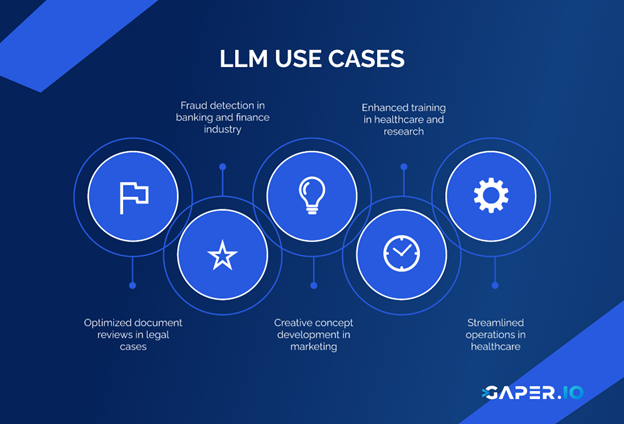
Document reviewing can be lengthy and prone to errors. With custom LLMs, there can be more streamlined checking, improved accuracy, and optimized efficiency.
Especially, in the case of complex texts, when there is just so much to analyze. If you are a legal firm, finetuning custom LLMs might be an excellent choice to raise your standards.
“I tried my hands-on learning more about Gen AI and LLM through free online courses, including Google cloud-sponsored training ….”
“After going through multiple articles, blogs, webinars, and seminars on emerging legal tech and grasping some of the use case studies, I have reconfirmed some of my assumptions on how things will shape up in the next few months and years from legal services perspectives.”
Animesh Kumar, Vice President – Contract, Compliance, and Commercial at Integreon
Are you a legal researcher who’s struggling to maintain consistency? Custom LLMs are your knight in shining armor. Firstly, LLM solutions save time by speeding up research.
Through AI tools and NLP, lawyers can enhance the quality of research. Sometimes, we miss out on the intricacies. In such circumstances, custom large language models upgrade the accuracy level.
The future of LLMs and AI is bright!
According to a PWC study, “AI could contribute up to $15.7 trillion1 to the global economy in 2030.” Most statistics and studies show that custom LLMs will become one of the most essential parts of how industries function.
However, it is important to remember that every coin has two sides. In this case, companies must know the implications of using custom large language models.
According to Joelle Pineau, VP of AI research at Meta, “The key is to balance the level of access, which can vary depending on the potential harm of the model.
“My hope, and it’s reflected in our strategy for data access, is to figure out how to allow transparency for verifiability audits of these models.”
Now that this article is coming to a close, it’s safe to say we’ve learned a few lessons. One of them is that AI and large language models are here to stay.
Industries continue to explore and develop custom LLMs so they work precisely according to their vision. However, at the same time, there must be some limitations, answerability, and ethical checking.
How will LLMs change the world?
The future of LLMs and AI shines bright. A PWC study predicts that AI could add a whopping $15.7 trillion to the global economy by 2030. It’s no surprise that custom LLMs will become crucial for industries worldwide.
However, with great power comes great responsibility. Companies need to recognize the implications of using these advanced models. While LLMs offer immense benefits, businesses must be mindful of the limitations and challenges they may pose.
What is the advantage of a company using its data with a custom LLM?
Custom LLMs excel in accuracy. This is because they are fine-tuned versions of large language models. The goal is to enhance customer experience. How? By bridging the gap.
Organizations understand the need to provide a superior customer experience. That’s where custom LLMs come in.
What are LLMs in AI?
Custom LLMs undergo industry-specific training, guided by instructions, text, or code. This unique process transforms the capabilities of a standard LLM, specializing it to a specific task.
By receiving this training, custom LLMs become finely tuned experts in their respective domains. They acquire the knowledge and skills necessary to deliver precise and valuable insights.
How are companies using LLMs?
Custom LLMs have become powerful tools in various industries, including marketing, healthcare, banking, and law. Let us talk about custom LLM use cases.
In marketing, custom LLMs assist in brainstorming creative concepts, generating personalized content, and automating content analysis. Their ability to monitor customer interactions and identify trends enhances marketing strategies.
In healthcare, these models aid in documentation, clinical support, and improved operations, reducing errors and improving patient care.
In banking and finance, custom LLMs automate customer support, provide advanced financial guidance, assess risks, and detect fraud.
In the legal field, they streamline document reviewing, enhance research quality, and ensure accuracy.
Custom LLMs are becoming indispensable in revolutionizing industries and delivering exceptional results.
What is the impact of LLM?
Large language models are changing content generation, customer support, research, and more. LLMs provide valuable insights, enhance efficiency, and automate processes.
However, there are concerns about overreliance on LLMs leading to a reduced diversity of ideas in research.
Additionally, the potential exposure of certain jobs to LLM capabilities may reshape labor markets. Despite these challenges, LLMs continue to evolve and drive advancements.
Top quality ensured or we work for free
